How to get the most out of hiring a B2B SaaS marketing agency (and avoid common pitfalls)
Last updated: February 18th, 2025
A lot of B2B SaaS companies will hire a marketing agency to help them fix their pipeline and revenue. They think it’ll be plain sailing once they find the right agency and that soon they’ll be able to reliably scale trials and demos.
But the reality is not always so straightforward. In fact, one of the main points of failure for agencies and clients alike is their onboarding process.
We have found that the first 100 days of any client project are crucial to the short, medium and long term success of their initiative.
This article outlines how we go about onboarding clients and specifically, we’ll cover:
- What some agencies and clients get wrong about starting a project together
- Why the first 100 days of the relationship are so crucial
- How our onboarding process ensures success
By the end of this article, you’ll have a firm understanding of how to make the most of the first 100 days with a SaaS marketing agency
At Powered By Search, we help B2B SaaS businesses achieve predictable growth through holistic demand generation, SEO, and paid media. To learn more, get your Free Marketing Plan here.
What agencies and clients get wrong about starting a project together
There are a number of ways that an agency client relationship can go wrong. But most of them come down to a failure to communicate effectively and not setting expectations.
In a moment, we’ll walk through how we go about ensuring that communication and expectation setting is done effectively – which ultimately makes our clients’ business grow more reliably.
But before we do that, let’s look at some of the common mistakes SaaS marketing agencies and B2B SaaS companies make when starting a project together.
1. Wanting and promising results too fast
SaaS founders and executives often come to us having been burned by a previous agency relationship.
Most of the clients we hear from have been attracted to work with us because of our B2B SaaS marketing strategy framework (the Predictable Growth Methodology) and are excited to get major results for their SaaS immediately.
This is a (very understandable) mistake. SaaS marketing agencies will often promise to deliver results within a very short timeframe because they believe clients will only sign on the dotted line when they do.
We frequently find clients expect results much faster than is reasonable.
To illustrate the problem with this: we used to run pilot projects for clients. The goal of these projects was to get quick wins while we focused on scoping out broader strategic projects that we’d run after the pilot phase.
While we were able to deliver short term results, over time our clients found that results delivered during that brief pilot project were diminishing. As you’d expect, this created mistrust from the clients and caused us a lot of issues with retention.
We have long since moved on from that model but most SaaS marketing agencies will still follow a similar structure in their work. The result is disillusionment from clients when short term wins are shallow and/or not achieved at all.
However, if you want to see faster results from your agency, you can help by beginning the engagement prepared. At Powered By Search, a few ways clients can come prepared and help us achieve results faster include:
- Have the requested intake information readily available (e.g., information on your target audience, what’s worked well with previous marketing campaigns, etc.)
- Have all of your stakeholders bought in and fully briefed in terms of what this agency has to offer and where they’re playing a role in the implementation or strategic consulting of achieving company goals.
- Access to clean data (you need to have a really tight and optimized CRM)
- Have existing paid media campaigns and a functional content marketing team.
Once we have this data, we can move faster, but it’s still a process and while you may see quick wins when we fix low hanging fruit, achieving long-term marketing success is an incremental process that doesn’t happen overnight.
For example, we’ll test various hypotheses and some will be true while others will not. We’ll also validate some of the initial expectations from the sales conversations.
So the short term might be a little bit bumpy, but this process lays the foundation for long-term success.
Finally, if there are any major unforeseen issues (e.g., something is unexpectedly broken, or something that was shared during sales conversations is invalidated), we communicate this to the client immediately to readjust expectations.
2. Failure to communicate and understand the context and function of the business
Every business we work with is unique. Even clients within the same market or industry are positioned completely differently and the internal workings and market familiarity of each company is different too.
Clients will often have a unique viewpoint on their business and the challenge ahead of them gained from years of experience and conversations with clients.
And while we’re experts in our craft and know how to deliver significant value for our clients, there is not an agency on earth that could divine the insights that it took their clients years to gain.
This means that SaaS businesses need to involve all the right people in their organisation and bring that market intimacy to the project, communicating it with their agency as clearly and exhaustively as possible.
Agencies are able to make guesses about a client’s customer, but even with research, they often miss things unless the client explains it clearly.
One of our clients, Rejoiner, is in the ecommerce email marketing industry.
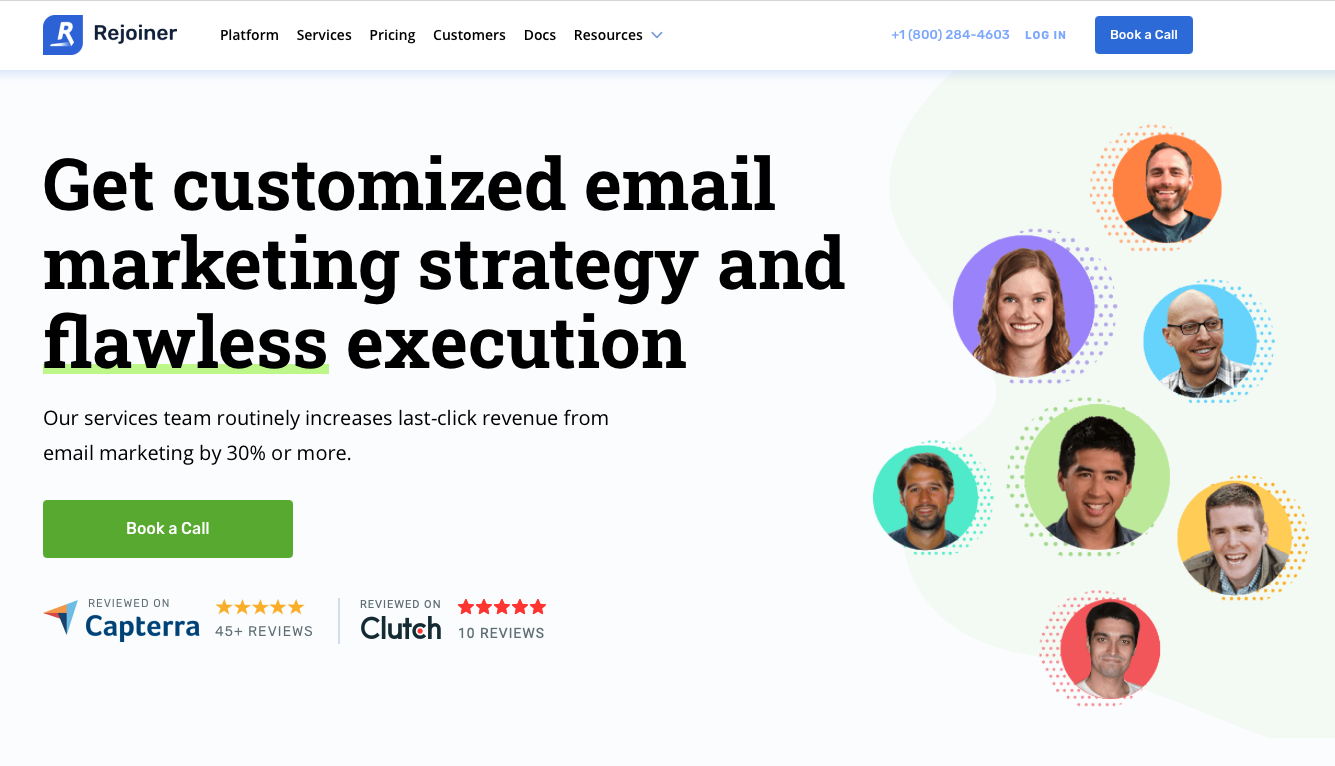
Their product has a huge number of features for managing the email channel at an ecommerce brand. Almost any agency would listen to their list of features and then build a marketing strategy around aligning those features to client pain points.
However, it was only when we asked more searching questions that we discovered the unique insight that our client had was: their customers really love them because they deliver incredible services in support of their tool such as done-for-you email design and lifecycle roadmapping.
3. Poor communication between management or sales with the clients
The final major failure point is what happens after signing the contract and agreeing the scope of work.
Clients are concerned that they’ll buy and then lose the interest of the people who know what strategic goals they’re trying to achieve.
And that’s totally warranted but most of the time, clients are passed from a sales exec to a team of tactical operators who will deliver SEO or PPC services without any knowledge of the sales conversation.
This is a huge error that agencies make.
B2B SaaS marketing requires a nuanced understanding of a product’s customers and agencies need to make sure that everyone working on the project has a clear picture of this and the unique challenges that their client trying to overcome.
Why the first 100 days of the relationship are so crucial
We believe that the first 100 days of a client’s engagement with a B2B SaaS marketing agency is where the success or failure of the project is decided.
We’ve just explored, in some depth, what agencies get wrong about SaaS clients and what SaaS clients miss out when they’re working with a new marketing agency.
But before we explain our process for building successful relationships with our clients, let’s dive into why the first 100 days are so important.
When an agency onboards clients, they’re setting the tone for the entire relationship and it often determines whether the partnership will be a success or failure.
If you begin the engagement with good momentum, you’ll likely carry that forward throughout the rest of the engagement. However, if the engagement starts slow, it’s much more difficult to course correct after the first 100 days and achieve faster results throughout the rest of the year.
To illustrate this concept, we use the 4 Futures Model.
In the diagram below, you can see that SaaS companies who begin with strong momentum usually end up either scaling or soaring, while SaaS companies that aren’t prepared at the beginning of the engagement tend to drift and see disappointing results throughout the rest of the engagement.
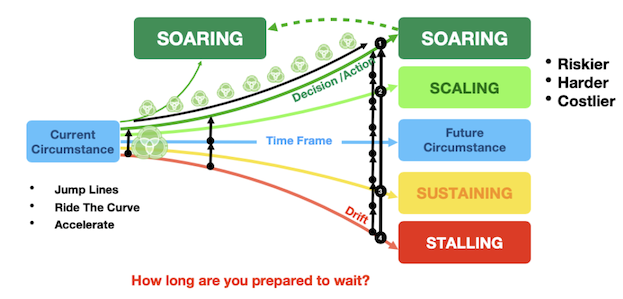
While it’s not impossible to course correct and shift gears from drifting to scaling/soaring, you’re much less likely to end up in the soaring category if you begin the engagement on the path to drifting.
SaaS companies that end up on the path to drifting are understandably disappointed and ultimately ask: “Did we do the right thing hiring this agency?”
More often than not, this is the fault of the agency as they likely failed to:
- Provide a defined blueprint for the first 100 days of the engagement.
- Communicate the data and materials they need from the client beforehand to succeed.
- Set realistic expectations for results they can achieve.
The peril here is two way:
On the one hand, agencies who don’t onboard clients effectively set themselves up for losing a client after a hundred days or so. And clients – particularly marketing execs within SaaS companies – risk reputational damage because they invested 100 days worth of their budget with little or nothing to show for it.
Now let’s take a look at how we help SaaS companies avoid these avoidable, costly mistakes.
How we structure our onboarding process to ensure the first 100 days are a success
Our onboarding process at Powered By Search is systemised and built up from a holistic perspective.
We create and publish a lot of content outlining our approach to specific marketing strategies and how we do things differently from other SaaS marketers. Here are just a few examples of this content:
- How we build demand generation flywheels for our clients
- Our system for clear and differentiated SaaS positioning
- How we set up LinkedIn Ads for clients
This means that by the time a client asks us to work with them to grow their SaaS, they’re extremely familiar with our methodology and are already aware of how we deliver results: predictably and steadily, not erratically or quickly.
1. Client enrolment to delivery teams
Below we’ll provide a brief overview of what the client enrollment process looks like at Powered By Search and how it sets our clients up for success during the first 100 days of the engagement.
1.1 Introduction To The Consultants On Our Team
The onboarding process itself starts with the ‘hand off’ from the sales team to our consultants.
While many agencies hand off clients to account managers, we at Powered By Search keep a relatively flat organizational structure and prioritize hiring expert consultants rather than operational and client management staff.
This means that the people who work on your account and collaborate with you directly are the expert consultants responsible for doing the work to get you to your goal.
By design, we don’t have account managers at Powered by Search. We believe you don’t need someone to hold your hand or to run interference between your team, and the experts who are actually leading your strategy and execution. Instead, we deliver higher value communication and results by connecting you directly to the senior consultants that are driving strategy & doing the work.
1.2 Share Recorded Sales Calls
We record all of our calls with the incoming client. That means that our consultants – who deliver the day-to-day work – are able to watch and learn everything that the client has told the sales team.
This is very unusual – most agencies don’t share recorded sales calls before starting a project. But because we do this, we ensure that on day 1 of a new project, expectations internally and externally are aligned.
1.3 Create a “Strategy Brief” One-Pager
From there, we create a one page strategy brief as the central source of truth for everyone on our team and on the client’s team. This explains goals, projects and the core levers we’ll pull to make the engagement successful.
While our brief contains the essential information on engagement goals, purpose, and proposed strategy, we purposefully keep it short, as long strategy documents are often overwhelming to clients.
If the client doesn’t read or fully understand the plan, it can be easy for expectations to become misaligned and the relationship won’t be successful.
1.4 Kick-Off Call
Where most agencies will use a client meet and greet as an opportunity to do just that, our meet and greet ‘kick-off’ calls also include a summary of the roadmap for the coming quarter.
That’s because while it’s great to see friendly faces – we’re very biased towards action.
1.5 Establish Communication And Project Management In Basecamp
We work from Basecamp rather than other tools like Slack or email. Using Basecamp means that our team can focus on doing good work for clients rather than responding in real time where tools that support this can mistakenly over-index on rapid activity rather than value.
But also: having our client in Basecamp with us increases the transparency of the relationship greatly, and fosters collaboration between client-agency.
1.6 Establish 30/60/100 Day Outcomes
Finally, as early as possible, we set up a meetings with the client where we align and track on the goals of the first 30/60/100 days. This addresses a number of the problems that other agencies have with the first 100 days such as: misaligned expectations, overpromising and also meeting the whole team.
2. Discovery – First 30 days
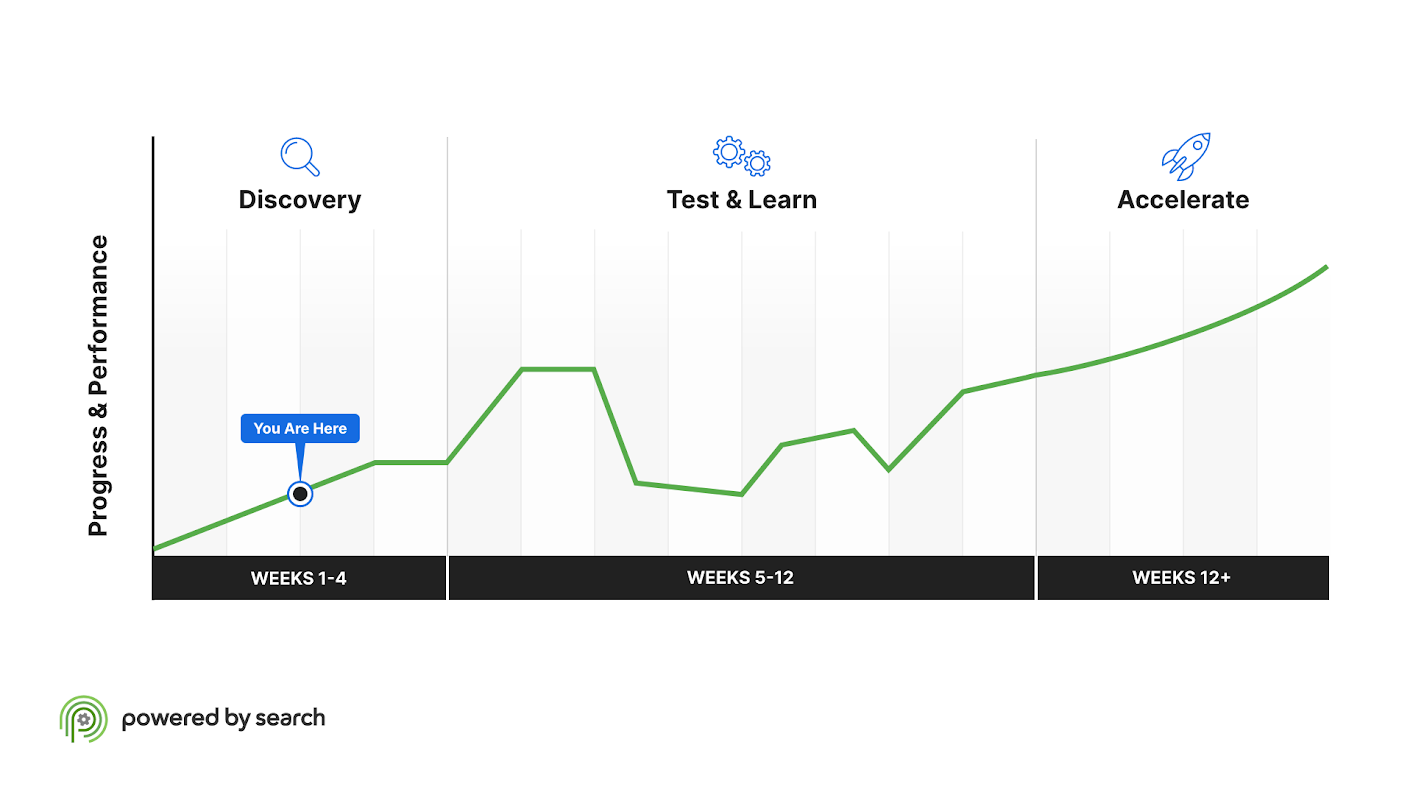
During the first 30 days of an engagement, we focus on deeply understanding the context of your business and your customers.
We also validate your channels and analytics, identify and execute the low effort/high impact quick wins, and lay the framework for your growth strategy.
Here are a few specific things we typically do during the first 30 days:
- Running through our pre-flight checklist – makes sure we know things like ‘What are the key metrics?’, ‘Do we have access to your CRM?’
- Internal sync up to make sure that everyone on the team knows what they’re doing and due to deliver for the client
- Our management team checks in with the client to ensure they’re staying on track with the deliverables we’ve asked for from them (operational things such as access to tools and accounts, for example)
- Collaborative workshops like the SaaS positioning canvas happen at this stage too – clear and crisp positioning is crucial to the overall success of any SaaS marketing project
- Building out the marketing operations by getting access to your data, making sure that it’s clean, and ensuring we can tie marketing outputs to sales and business outcomes (e.g., can we attribute close/won revenue all the way through the pipeline to the marketing work that we’re doing?). This allows us to lay the groundwork of the reports we co-create with our clients to show the financial value Powered By Search has provided over time.
- Execute discovery, forecasting and roadmapping to establish conservative, realistic, and stretch forecast ranges. This provides a much more practical estimation as it’s based on data and accounts for multiple variables rather than a single number. In addition, a client won’t know if the single number is a conservative, realistic, or optimistic estimate, which can severely impact client expectations.
- Create a ‘hypothesis log’ that allows us to build hypothesis driven strategies that are well-informed, high conviction bets that often have an 80%+ probability of being true based on our in-depth B2B SaaS marketing expertise. We continually test & learn with high agility to get you the best result.
Additionally, while the KPIs aren’t usually moving up and to the right until the end of the first 60 days (because the execution work is so extensive and just getting ramped up), we get started on account diagnostics such as PPC and SEO audits in the first few weeks of an engagement.
Even though the first 30 days are mainly focused on researching and identifying opportunities, we believe that it’s important to err on the side of over-communicating so that we’re well aligned with the client.
Specifically, here’s the communication you can expect from us during the first 30 days:
- Status updates (what’s been done, next, early insights/wins) that are 5 min or less video or read.
- Feedback requests – a question we commonly ask our clients is “On a scale of 1-10, where are we at right now in terms of your sense of progress toward your goal?” so we specifically know that we’re on or off track from the client’s point of view.
- Skip-level touchpoints with Powered by Search’s leadership team
By constantly communicating our progress and building the client relationship, the long term roadmap we deliver at the end of these 30 days typically requires very few edits, which helps us hit the ground running and make the most of the first 100 days of the engagement.
3. Test & Learn – Day 30-60
We’re typically not implementing any changes until roughly the fourth week of the engagement, so we advise our clients not to expect to see significant performance impacts immediately.
After the first 30 days of discovery is done, the next phase of the engagement is running small measured tests from our growth strategy. However, these aren’t random tests.
We’re using data from the hypothesis log to make measured bets and we track every test we run to iterate on campaigns that worked and avoid making the same mistakes twice.
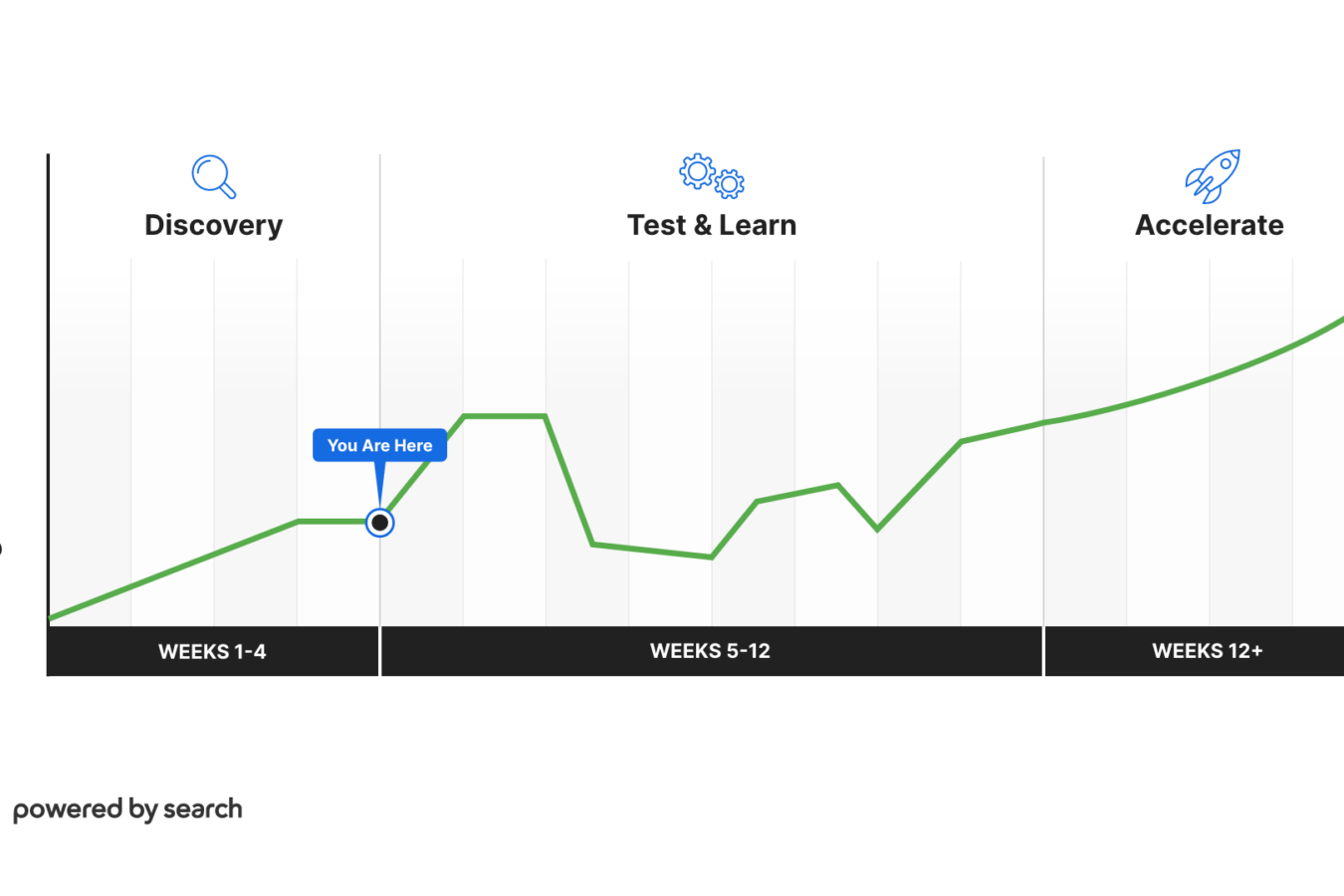
During this period, all the relevant teams (demand gen; SEO; and paid media) will begin to run through our playbooks.
For example, SEO will begin working through our SEO roadmap for early wins which includes activities like:
- De-indexing blog posts that aren’t thematically related to search intent
- Adding internal links to features and benefits pages on relevant blog posts
- Creating competitor comparison pages
- Adding depth to features and benefits pages
- Turning battle cards into blog content
The goal of this phase is to test our assumptions about how to grow demand for our SaaS clients. Between weeks 5-12 we often adjust and retest our strategy if the data says that we should.
In fact, it’s not uncommon for performance to go through significant fluctuations during this period. This is because platform algorithms need to complete their learn period, and we’ll sometimes learn that hypotheses from sales conversations may prove untrue after testing.
Therefore, it’s normal for the performance and progress of this phase to feel normal, though this step is essential to dial in for long-term growth.
Nevertheless, this phase won’t last long and we’ll communicate our learnings with you along the way.
Once we’ve figured out what works, the next phase is when clients start to see promising results. Yet these wins are the tip of the iceberg.
Each SaaS company is unique, so once we fully understand what works, we’ll scale the strategy.
4. Accelerate – Day 60+
During weeks 5-12, it’s normal for clients to feel some nervousness about the engagement as you might have learned a few things over the first 60 days that you didn’t learn before, and expectations might have changed from what you were thinking when we first started working together.
This is normal.
Do you remember the last time you took on a project, started learning a new skill, or changed an unhealthy habit?
The first few days are exciting and full of opportunity, but after a few weeks, you start to think, ‘this is way harder than I thought’ or ‘why am I not improving?’
Almost every client we’ve had has felt like this at one point.
Yet after our first few weeks, we’ll establish a rhythm, and you’ll see ever increasing bright spots.
It is completely normal to feel a bit uneasy right around now.
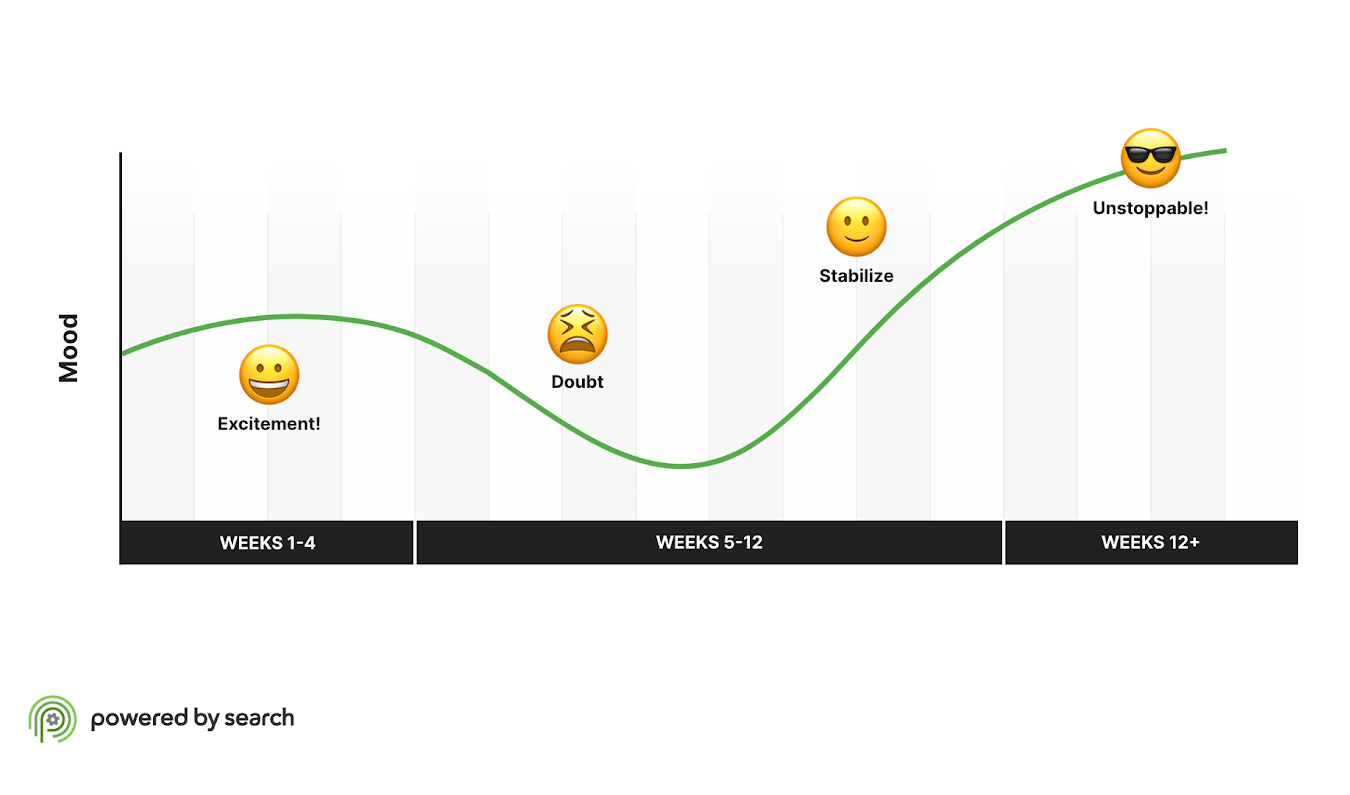
The good news is that after the discovery and testing phase, we get a clear understanding of what works so that after day 60 – or thereabouts – we scale what works to deliver consistent growth for our SaaS clients.
Clients typically see significant increase in demand driven by our SEO, paid media and demand generation work by this point.
Once that happens, we’ll optimize accounts to further increase the growth rate.
Setting the stage for the first year
The path to predictable growth and ROI through your first year of working with Powered By Search involves three key stages:
- Strategy: This is the first 100 days that we discussed in this post. We focus on framing your strategy and you’ll get prioritized high impact, low effort quick wins.
- Validation: During months 3-6 and we validate the strategy we established in the first 100 days. This is where performance ramps up but not often in a linear fashion. You’ll get incremental performance and ROI improvements as hypotheses are tested and confirmed.
- Return (ROI): During the second half of the first year you’ll start to see the return on your investment scale and enjoy the beginnings of predictable growth.
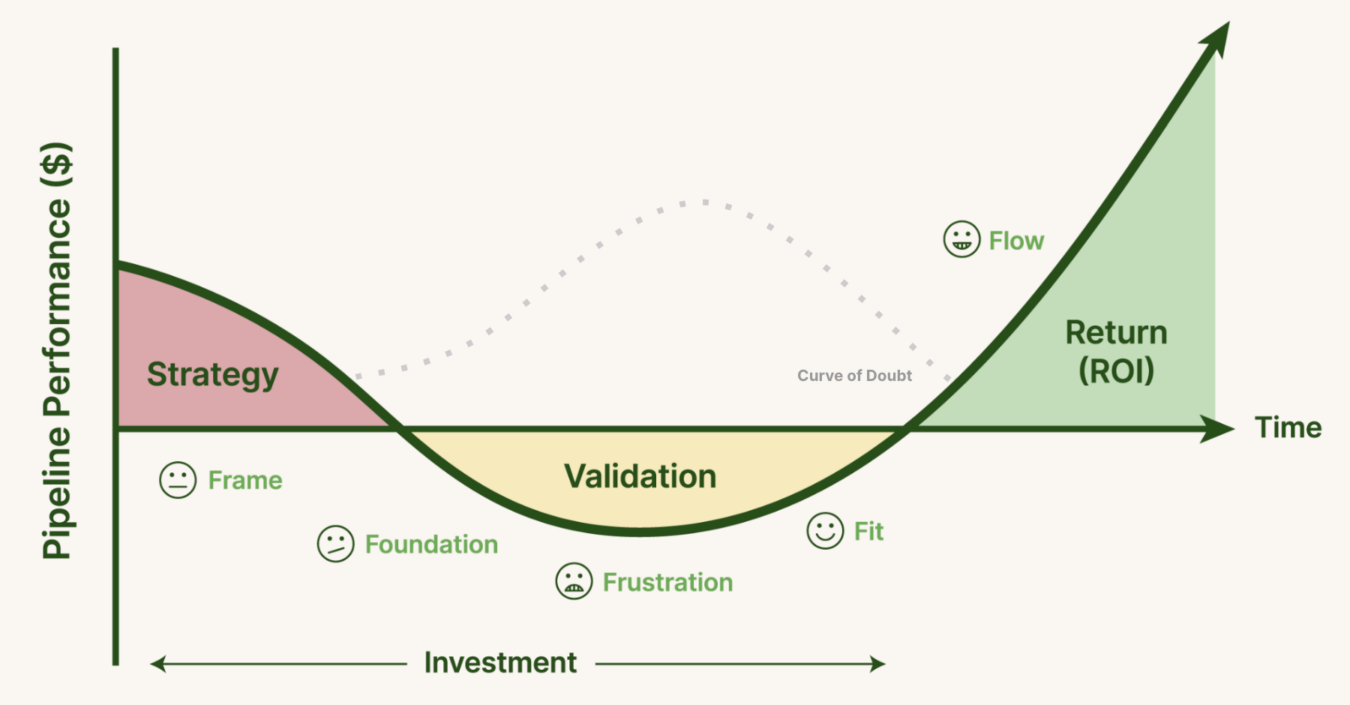
Every quarter, we’ll work through the strategy, implementation, and results feedback loop to ensure the engagement is on track to hit your goals.
1. Strategy
Every 90 days we’re refreshing the forecast and the strategic roadmaps based on what we’ve learned from previous campaigns and tests recorded in the hypothesis log.
2. Implementation
After analyzing and improving the strategy, we execute our proven playbooks for each channel you’re leveraging. To give you an example, here are just a handful of our playbooks just for content marketing and SEO:
- How to Create Pain Point Content That Converts for B2B SaaS
- How B2B SaaS Companies Can Leverage a Hub & Spoke Content Strategy
- How to Design B2B SaaS Blogs for Conversion
3. Results and Reporting
With most of our clients, we deliver monthly and quarterly reports.
The monthly reports show how we’re moving towards your targets and illustrate that we’re not just reacting to short term events and instead are moving ahead towards the overall goal: generating more customers and increased revenue.
Specifically, each monthly report highlights:
- Insights: What’s working, what’s not working, and what did we accomplish?
- Importance and Impact: Why does this matter to your KPIs? Why is it important?
- Input: Where do we need to collaborate on next steps?
Next, the quarterly business review (QBR) is a call with key stakeholders on the marketing team that highlights wins, opportunities, and challenges.
On this call, we’ll have a deeper discussion on the strategic roadmap so that we’re clear on the goal direction and progress and the roles we each play in its success.
We’ll discuss wins, opportunities and challenges over the past quarter and evaluate results achieved compared to forecast projections. We then repeat this process so that each quarter builds on the previous one so that you have a compounding flywheel.
During the QBR, we’ll also provide an update on your 4 Futures trajectory so that you know if you’re currently stalling, sustaining, scaling, or soaring.
If you’re ever sustaining or stalling we’ll have a critical discussion on what needs to be done to get back on track. If you’re scaling or soaring, we’ll continue accelerating toward making your SaaS business unstoppable.
ROI after the first year
While the first 100 days will focus mainly on learning about your business, testing hypotheses, and identifying what works, you’ll see the fruits of this effort as the year progresses.
For example, here are two examples of the ROI we delivered for clients in their first year with us:

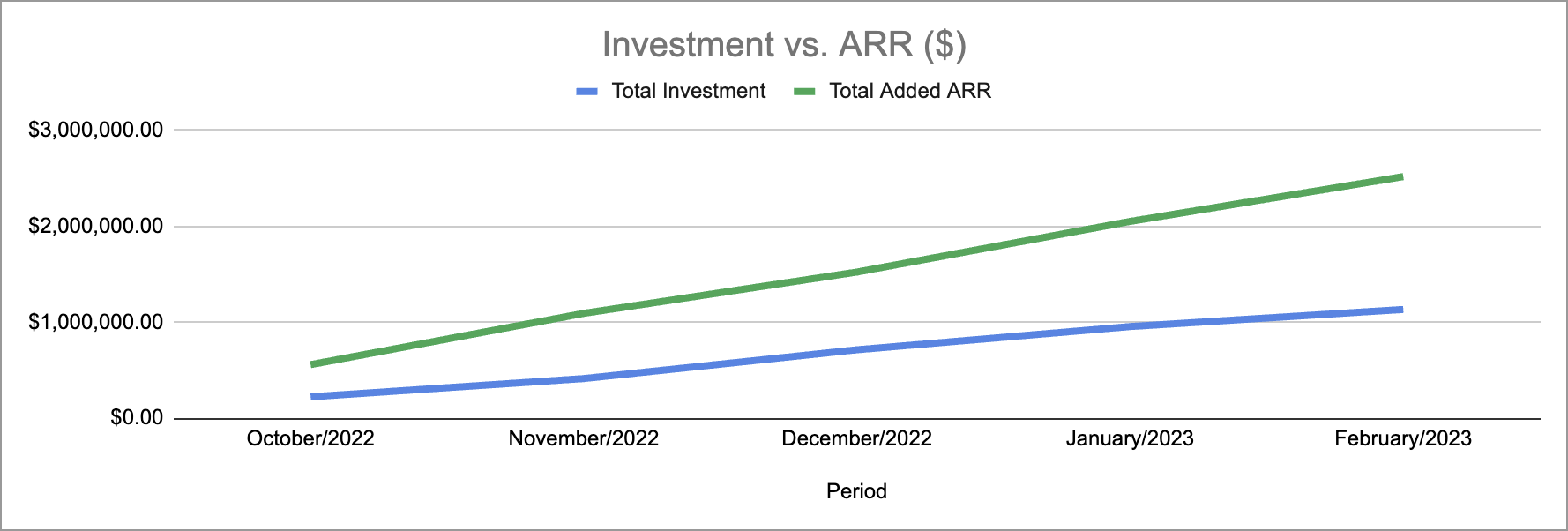
As we continue to iterate on our program and partnership together, you’ll continue to see compounding results like these clients have in multi-year engagements with us:
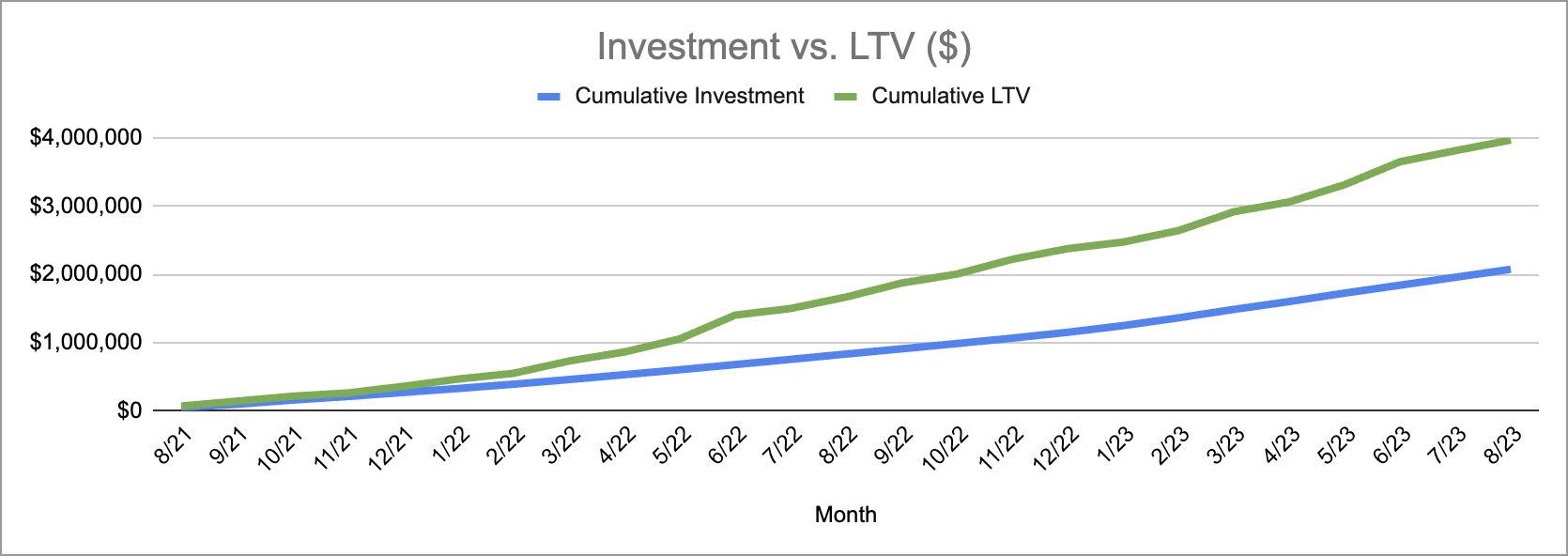
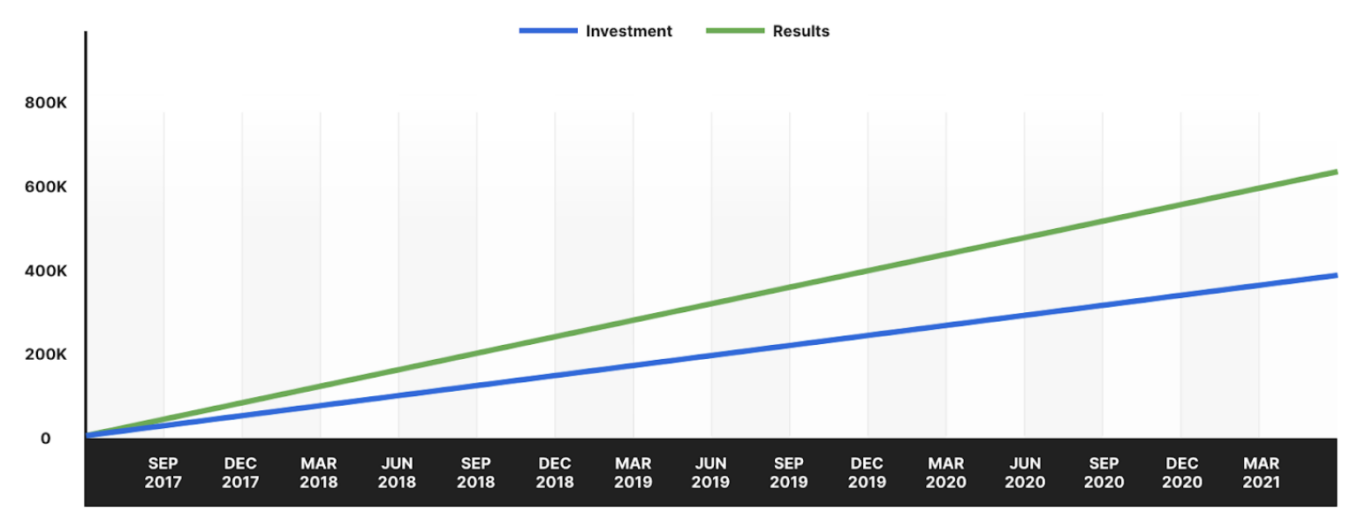
Start your agency relationship the right way
B2B SaaS companies often have bad experience with marketing agencies. More often than not, this is due to:
- Expecting results sooner than is realistic and becoming disillusioned
- Failure of the agency to communicate with the client and set realistic expectations
- Poor hand off between sales and consultants within the agency
- Significant failures in onboarding new clients into the agency
We have found that the first 100 days of any client project are crucial to the short, medium and long term success of the relationship.
That’s why we invested significant resources into building a client relationship development process that avoids the common pitfalls SaaS marketing agencies and clients face so that we deliver predictable growth every time.
If you’d like to learn more about how we can help your B2B SaaS achieve long-term predictable growth, get your Free Marketing Plan here.
What you should do now
Whenever you’re ready…here are 4 ways we can help you grow your B2B software or technology business:
- Claim your Free Marketing Plan. If you’d like to work with us to turn your website into your best demo and trial acquisition platform, claim your FREE Marketing Plan. One of our growth experts will understand your current demand generation situation, and then suggest practical digital marketing strategies to hit your pipeline targets with certainty and predictability.
- If you’d like to learn the exact demand strategies we use for free, go to our blog or visit our resources section, where you can download guides, calculators, and templates we use for our most successful clients.
- If you’d like to work with other experts on our team or learn why we have off the charts team member satisfaction score, then see our Careers page.
- If you know another marketer who’d enjoy reading this page, share it with them via email, Linkedin, Twitter, or Facebook.